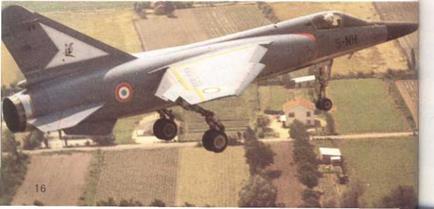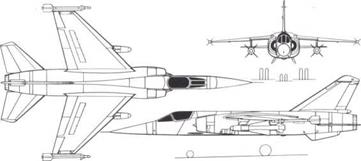Dassault Mirage FI
Mirage F1 .C
Origin: Avions Marcel Dassault/Breguet Aviation. France, in partnership with A6rospatiale, with Fairey and SABCA, Belgium, and CASA, Spain: licence production in S Africa managed by Armaments Development and Production Corporation,
Type: Single-seat multimission fighter.
Engine: (FI C) 1 5,8731b (7200kg) thrust (maximum afterburner)
SNECMA Atar 9K-50 single-shaft augmented turbojet: (F1.E) 18,7401b (8500kg) thrust (maximum afterburner) SNECMA M53-02 single-shaft augmented by-pass turbojet.
Dimensions: Span 27ft 6Jin (8-4m); length (F1.C) 49ft 2^in (15m): (F1.E) 50ft 11 in (15.53m): height (F1.C) 14ft 9in (4-5m); (F1.E) 14ft 10ii’n (4.56m).
Weights: Empty (F1.C) 16,3141b (7400kg): (F1.E) 17,8571b (8100kg): loaded (clean) (F1.C) 24.030lb (10,900kg): (F1.E) 25.450lb (11,540kg): (maximum) (F1.C) 32.850lb (14,900kg): (FI. E) 33,5101b (15,200kg). Performance: Maximum speed (clean, both versions) 91 5mph (1472km/h) (Mach 1 -2) at sea level, 1,450mph (2335km/h) (Mach 2-2) at altitude (with modification to cockpit transparency and airframe leading edges F1 .E capable of 2-5): rate of climb (sustained to Mach 2 at 33,000ft) (F1.C) 41,930-47,835ft (12,780-14,580m)/min: (F1.E) above 59.000ft (18,000m)/ min: service ceiling (F1 C) 65,600ft (20,000m): (F1 E) 69,750ft (21,250m): range with maximum weapons (hi-lo-hi) (F1.C) 560 miles (900km): (F1.E) 621 miles (1000km): ferry range (F1.C) 2.050 miles (3300km): (F1.E) 2,340 miles (3765km).
Armament: (Both versions), two 30mm DEFA 5-53 cannon, each with 135 rounds: five Alkan universal stores pylons, rated at 4,500lb (2000kg) on centreline, 2.800lb (1350kg) inners and 1,1001b (500kg) outers: launch rails on tips rated at 2801b (120kg) for air-to-air missiles: total weapon load 8,820lb (4000kg). Typical air combat weapons, two Matra 550 Magic or Sidewinder on tips for close combat, one/two Matra 530 with infrared or radar homing, and one/two Matra Super 530 for long-range homing with large changes in height. Wide range of weapons for surface attack, plus optional reconnaissance pod containing cameras, SAT Cyclope infrared linescan and EMI side-looking radar.
History: First flight (FI -01) 23 December 1966: (pre-production F1-02) 20 March 1969: (production F1 ,C) 1 5 February 1 973: (F1-M53, prototype for proposed F1 ,E) 22 December 1974: (F1.B trainer) 26 May 1976: service delivery (F1 C) 14 March 1973.

Below: Though it has a much smaller wing than delta Mirages this F1 ,C of the 5e Escadre de Chasse carries more and lands slower.
|
Three-view of the F1.C with Matra R 530s and Sidewinders. |
Users: Ecuador. Egypt, France, Greece, Iraq, Kuwait, Libya, Morocco, S Africa, Spain.
Development: Recognising that the Mirage III family would eventually have to be replaced, the French government awarded Dassault a development contract for a successor in February 1964. This aircraft was the large Mirage F2, in the 20 ton (clean) class and powered by a TF306 turbofan engine. It broke away from the classic Mirage form in having a high-mounted conventional swept wing with efficient high-lift slats and flaps, used in conjunction with a slab tailplane. It flew on 12 June 1966. Dassault, however, had privately financed a smaller version of the F2, called F1, sized to be powered by a single’ Atar engine. This became increasingly attractive and effort was progressively transferred to it from the F2. It went supersonic on its fourth flight and. though it later crashed, the Armee de I’Air decided to buy 100 as replacements for the original Mirage INC interceptor and Vautour NN. Thus was launched an aircraft which in most ways marks a tremendous advance on the tailless delta.
Thanks to the far higher efficiency of the new wing the field lengths and take-off and landing speeds are lower than for the delta Mirages, even though the weights are greater and the wing area much less. Increased thrust comes from the latest Atar engine and among the many less obvious advances are the Cyrano IV multi-mode radar and integral tankage for 45 per cent more fuel (trebling patrol endurance and doubling ground-attack mission radii). Combat manoeuvrability in many situations was increased by as much as 80 per cent and the all-round performance of the new fighter was outstanding. Sales to Israel were prohibited, but orders were soon placed by South Africa and Spain, the former also buying a manufacturing licence. More recently the F1 was chosen by several Middle East countries and many more sales seem certain.
In 1967 the French engine company, SNECMA, began the design of a completely new engine for the Super Mirage. To test the engine the F1 was an obvious choice, and the combination could not fail to be of interest in its own right. The M53 engine confers benefits in acceleration, climb, manoeuvrability and range and, to make up a more modern package, Dassault-Breguet proposed the fully modular Cyrano IV-100 radar and the SAGEM-Kearfott SKN 2603 inertial navigation system, as well as the SFENA 505 digital autopilot of the F1 .C. The result is the F1 ,E, which from early 1974 was strongly, but unsuccessfully, pressed on overseas customers, particularly Belgium, the Netherlands, Denmark and Norway (which agreed a common objective in replacing their F-104Gs). The Armee de I ‘Air did not want the F1 .E, but had agreed to buy a limited quantity had it been chosen by the four NATO nations. Two M53-powered prototypes were flown, but the M53-engined version was shelved in 1975. Today four versions are in production: (C) the basic aircraft, so far chosen by all customers: (E) the C with more advanced avionics (no longer offered with the M53 engine), chosen by Libya: (A) simplified avionics for low-level attack, for Libya and South Africa: (B) two-seater, for Kuwait and Libya.











